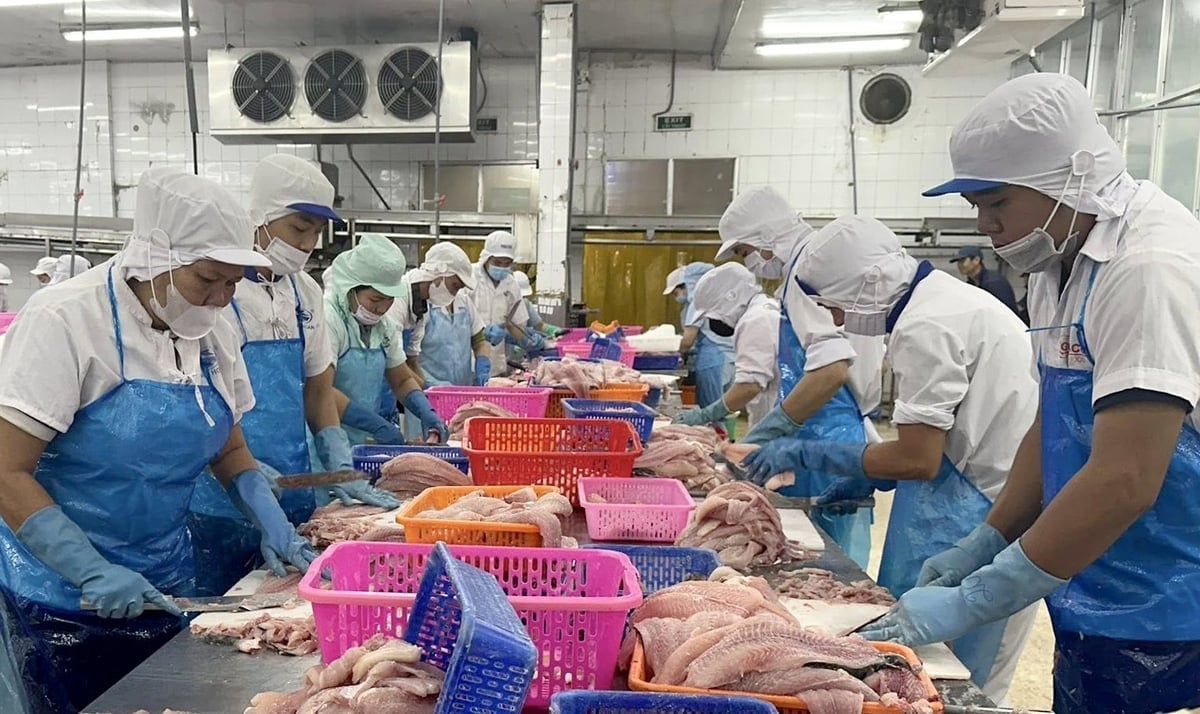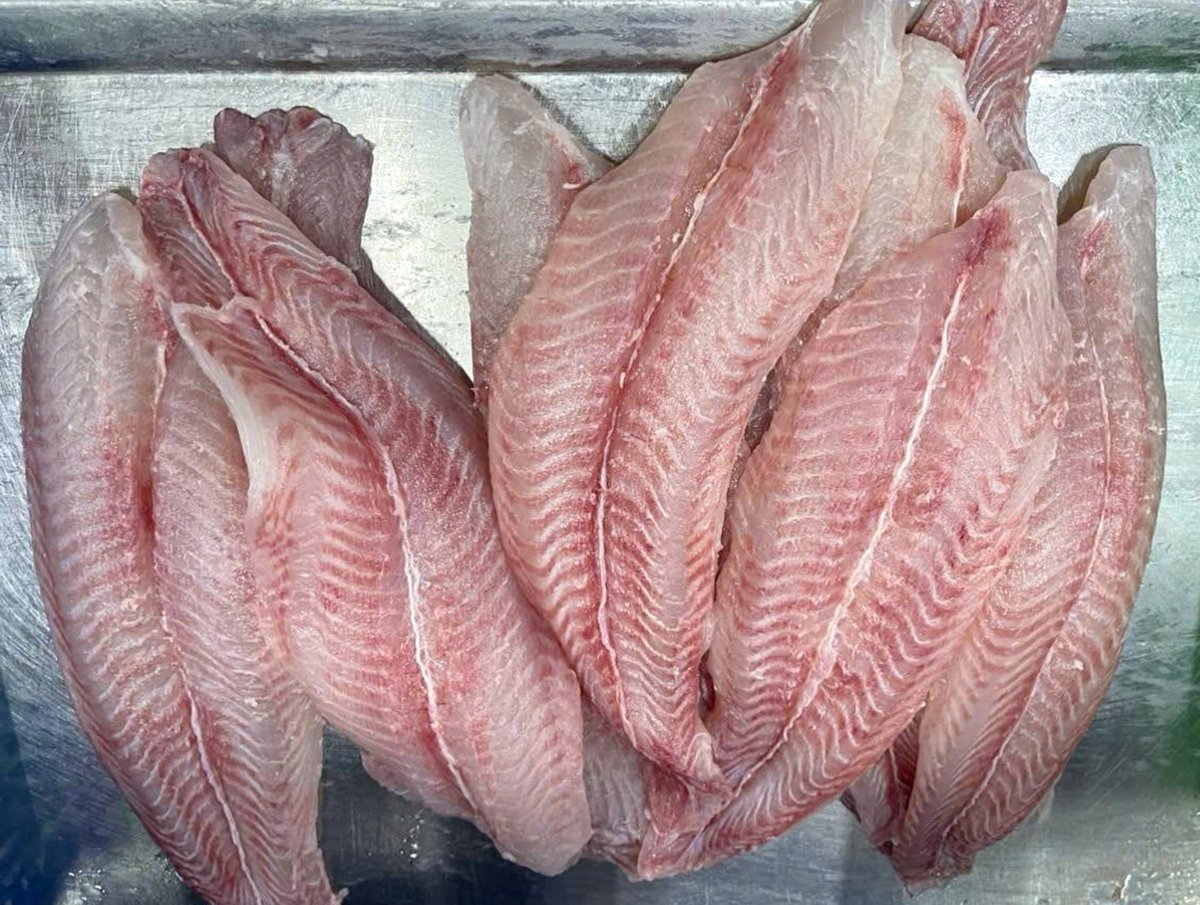November 28, 2025 | 10:23 GMT +7
November 28, 2025 | 10:23 GMT +7
Hotline: 0913.378.918
November 28, 2025 | 10:23 GMT +7
Hotline: 0913.378.918

Processing pangasius for export. Photo: Thanh Son.
Pangasius exports since the beginning of the year have shown quite good growth. Mrs. Le Hang - deputy general secretary of the Vietnam Association of Seafood Exporters and Producers (VASEP) - said that in the first six months of the year, pangasius export turnover reached USD 1 billion, up 11.4% compared to the same period in 2024.
Although currently experiencing negative growth due to high inventory, China and Hong Kong remain the largest markets for Vietnamese pangasius, with a turnover of USD 249 million, down 4% compared to the same period last year.
While exports to China decreased, pangasius exports are growing in many other markets. In the first six months of the year, pangasius exports to the United States reached USD 175 million, up 10% compared to the same period in 2024. Exports to other major markets such as Brazil and Mexico also recorded good growth.
After the United States officially applied countervailing duties, pangasius exports to the US will be affected to some extent. However, Mrs. Le Hang assessed that pangasius exports to the US remain more optimistic compared to shrimp because competitive pressure is much lower.
First, Vietnamese pangasius almost completely dominates the US pangasius market. Second, there is positive news from the 20th administrative review (POR20) of anti-dumping duties on frozen pangasius and basa fillets imported from Vietnam.
According to the final results of POR20, seven Vietnamese enterprises received an anti-dumping duty rate of 0%. In addition, Vinh Hoan Company - the largest pangasius exporter in Vietnam - was removed from the anti-dumping lawsuit. Thus, in the near future, when exporting pangasius to the US, these eight companies will not face the situation of "tax on tax", thereby helping the pangasius industry continue to maintain the US market.
Although there is still optimism about the US market, the pangasius industry is also making efforts to minimize pressure from countervailing duty policies. Among these, the top solution is to increase processed and value-added (VA) products. VA products not only help enterprises diversify their export portfolio but also spread risks and optimize cost structures in the long term.

Pangasius fillets - the key export product of Vietnam’s pangasius industry. Photo: Thanh Son.
Information from VASEP shows that exports of VA pangasius products are growing very strongly this year, especially in the US market. In the first half of the year, VA pangasius exports to this market reached nearly USD 10 million, up 459% compared to the same period last year (equivalent to 5.5 times). The US accounted for 38% of the total value of Vietnamese VA pangasius exports to all markets in the first half of the year.
Three-digit growth in the US market has helped VA pangasius exports to other markets achieve high growth. From the beginning of the year to mid-July, VA pangasius exports reached USD 28 million, up 47% compared to the same period in 2024.
In addition to the US, many European countries and ASEAN have also begun to increase imports of VA pangasius products from Vietnam. This shows that the direction of improving quality and diversifying products by enterprises is producing clear results. Enterprises expect that in the near future, VA product exports could account for 20-25% of the total export turnover of the entire sector, instead of just a few% as in previous years.
Market diversification is also a necessary path for Vietnamese pangasius. At present, many markets and customers are showing demand for importing pangasius. Mr. Tran Van Hung, chairman of the board and general director of Hung Ca Company Limited, said that the company’s traditional customers have high demand for pangasius imports. Therefore, Hung Ca’s pangasius products are selling out as soon as they are produced. Last year, the total export value of pangasius products from Hung Ca was about USD 300 million. This year, that figure will be higher.
Although facing challenges from US countervailing duties, many enterprises remain optimistic about the future of Vietnamese pangasius because, while many countries farm pangasius, only Vietnam has established a pangasius industry with a complete value chain, compliance with international standards, and synchronization in sector strategy. Therefore, although Vietnam’s pangasius production accounts for only about half of global production, the country supplies more than 90% of frozen pangasius fillets to the world.
With traditional market demand in the final months of the year, along with the ability to expand into ASEAN, the Middle East and South America, plus taking advantage of the favorable results of POR20 in the US, VASEP forecasts that pangasius exports this year will reach USD 2 billion.
Translated by Huong Giang

(VAN) The signing of a protocol between Vietnam and China on the export of fresh jackfruit represents a significant milestone in agricultural trade cooperation between the two countries.

(VAN) On November 27, the Ninh Binh Department of Agriculture and Environment and the Institute for Green Growth Research organized a training course on greenhouse gas inventory for businesses.

(VAN) China’s cooking oil is suddenly flooding into India. It all comes down to a soybean surplus that Beijing doesn’t quite know what to do with.

(VAN) An Giang promotes supply-demand connections, standardizes quality and builds value chains, creating a foundation for sustainable bird’s nest development and aiming to expand exports.
/2025/11/24/5339-4-nongnghiep-075331.jpg)
(VAN) Recently, the conference on 'Sustainable Fisheries Linkage Chain - Tilapia for Export' took place in Tien Hai commune, Hung Yen province.
/2025/11/21/4309-2-153400_128.jpg)
(VAN) Green and low-emission rice is paving the way for Vietnamese rice to enter high-end markets, marking the beginning of a transformation journey toward greening and elevating the national rice brand.

(VAN) ‘Right to Win’ outlines a national action plan that shapes a new vision for Viet Nam’s agriculture in an era of renewal and global integration.